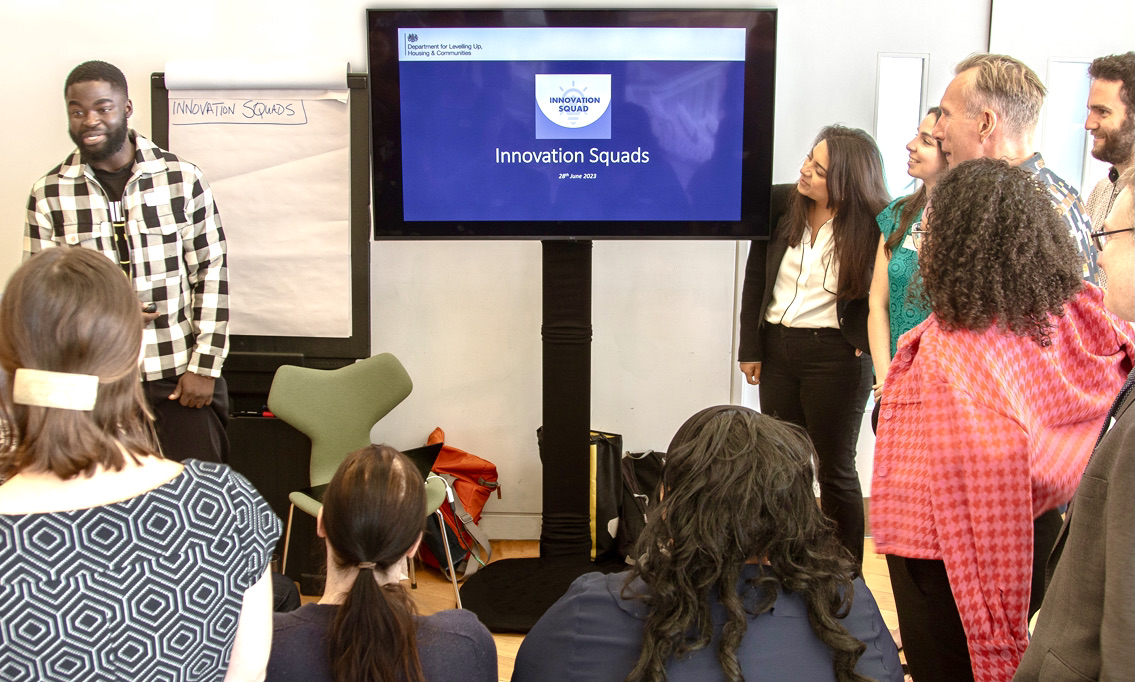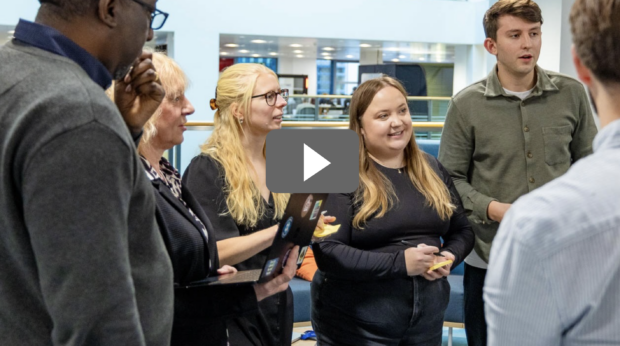
Government always seeks new ways to increase efficiency, solve problems and make improvements. Here in our department, we continually drive process improvements through multiple initiatives.
In this post, we’ll talk about our latest initiative: Innovation Squads.
We formed a squad team of 6 colleagues, drawn from different specialisms and divisions across the department who had never worked together before. The team was given 6 weeks to improve a process of their choice anywhere in the organisation. We asked them to be creative, think innovatively and be unafraid to disrupt.
The results have exceeded our expectations. Our first squad has built the department's first chatbots to help colleagues find accurate information faster and we are excited to see what this means for the future of piloting chatbots and AI in the department.
How it all started
Our digital teams have worked in multidisciplinary agile teams for years. Taking inspiration from Virgin Media’s Innovation Squads, we wanted to pilot an Innovation Squad concept with non-digital colleagues.
Our priority was to enable the department to solve problems and seize opportunities with speed and efficiency. By assembling a small but empowered team, we were able to leverage the collective expertise and diverse perspectives of our talented individuals, despite them having never worked together before.
We gave our squad the freedom to look into every corner of the department to find process improvement opportunities.
What the squad did
The squad was multidisciplinary by design, meaning members were able to use their diverse experience to brainstorm opportunities for greater efficiency. While there were many niche processes the squad felt could be improved, it was unanimously agreed that finding information internally more easily was a pain point the whole squad had experienced.
Following an intense problem storming workshop, the squad agreed that fast and accurate information retrieval was a problem that was worth solving and could be of benefit to the entire department. It was also one they could feasibly solve in such a short timeframe, having only 6 weeks to work with. The squad reported that HR information in particular was difficult to find, but would be of most value to help improve, which was supported by HR data.
The squad drew inspiration from technological advances and decided to explore the world of chatbots and AI as an alternative solution. Over the next 2 to 3 weeks, the squad gathered as much data, insight and knowledge as possible, through analytics, and speaking to HR, Technology, Cyber and Data protection colleagues and fellow innovators across government.
By the end of the 6 weeks, 2 solutions were prepared and presented to the department:
- A manually scripted chatbot called ‘HR Harry’, built using Microsoft’s Power Virtual Agents app, by squad members who had no prior coding knowledge
- An AI chatbot using Azure OpenAI + cognitive search which ingested our (very large) HR handbook and integrates with OpenAI’s ChatGPT product
HR Harry became a built and completed product shared with the HR department while the AI chatbot remains in a test environment.
Both solutions have the potential to increase efficiency for colleagues seeking to get answers and allow HR to reduce the time spent answering frequently asked questions (FAQs), to focus on more high value work.
Taking the squad’s chatbot solutions forward
Our next steps are supporting our HR department to embed HR Harry into their suite of internal digital services and supporting other functions to test and develop their own chatbots.
The department will be testing and experimenting with AI chatbots, but doing so carefully to make sure the technology delivers what is needed safely and securely. Before AI can be used formally in the department, the benefits and issues must be carefully considered, and appropriate approval provided.
We think it’s valuable for the department to start experiencing chatbots, and to understand what this experience feels like for users. It’s important that our innovative solutions are co-designed, so we deliver solutions that work for our users and keep their trust as we experiment.
What we learnt from our first Innovation Squad
Here are the most important learnings that we’ll take forward into our next Innovation Squad:
More support for the squad
A group of people who don’t know each other and haven’t worked together before need a good amount of support (for example daily check-in meetings, weekly summaries arranged for them). A squad is a flat structure with no hierarchy and therefore having support in place helps the team focus on problem solving as opposed to operations. In our first pilot squad, we let the team self-manage but advised them to use scrum-style ceremonies. Next time, we’ll schedule ceremonies for the squad by default.
Set a team charter
When setting up a squad, a team charter is a valuable way to align working responsibilities across a new group of people, working alongside a holiday chart so that everyone knows team members’ availability from the onset. We moved too fast and missed the opportunity to do this early in the pilot and it quickly became obvious that it was essential.
Formalise a ‘Week 0’
Before we started brainstorming, we gave the team a week to get comfortable and get all the introductions, understanding of goals and Agile crash courses out of the way first, so they would be ready to start. This was a decision we made at the start of week 1, and we quickly realised its importance.
Expand recruitment
We relied on Line Manager nominations to recruit squad members, but in the future, we’d like to also allow self-nominations in order to attract colleagues with a learning mindset, who are excited to take on a new challenge.
Formalise support for the squad
A Delivery Manager and Product Manager are essential to keep momentum, support and steer a new group. It also helps to have primed senior leaders in each division within the department to support, unblock and champion the squad’s mission to innovate.
Next steps
The Innovation Squads initiative represents a significant step towards driving innovation and problem solving within our organisation. Our intention is to enrich what we learn even further by engaging with colleagues both within and beyond government, fostering a broader impact. Given the success of the pilot, our senior leaders are supporting us to set up more Innovation Squads.
We’d love to share our experience and continue to learn from others across government. If you’re already working on something similar, or are considering this type of initiative, let's talk!
Drop a comment in the comment box or get in touch with our Innovation Squads Team.
Don't forget to subscribe to this blog for the latest updates from the team.


